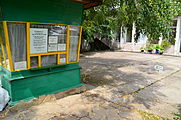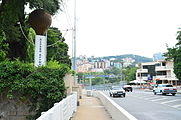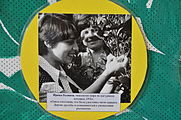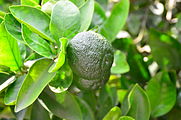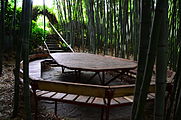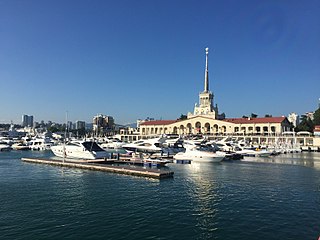
Sochi is the largest resort city in Russia. The city is situated on the Sochi River, along the Black Sea in the North Caucasus of Southern Russia, with a population of 466,078 residents, and up to 600,000 residents in the urban area. The city covers an area of 176.77 square kilometers (68.25 sq mi), while the Greater Sochi Area covers over 3,502 square kilometers (1,352 sq mi). Sochi stretches across 145 kilometers (90 mi), and is the longest city in Europe, the fifth-largest city in the Southern Federal District, the second-largest city in Krasnodar Krai, and the sixth-largest city on the Black Sea.
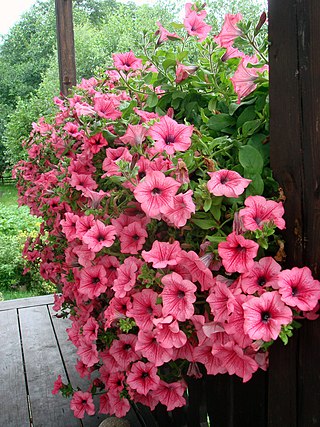
Ornamental plants or garden plants are plants that are primarily grown for their beauty but also for qualities such as scent or how they shape physical space. Many flowering plants and garden varieties tend to be specially bred cultivars that improve on the original species in qualities such as color, shape, scent, and long-lasting blooms. There are many examples of fine ornamental plants that can provide height, privacy, and beauty for any garden. These ornamental perennial plants have seeds that allow them to reproduce. One of the beauties of ornamental grasses is that they are very versatile and low maintenance.
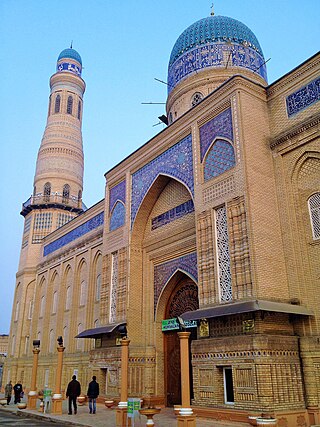
Andijan, also spelt Andijon and formerly romanized as Andizhan, is a city in Uzbekistan. It is the administrative, economic, and cultural center of Andijan Region. Andijan is a district-level city with an area of 74 km2 (29 sq mi). Andijan is the most densely populated city with density of 10,000 people/km2 and it had 747,800 inhabitants in 2024. Andijan is located in a tense border region at the south-eastern edge of the Fergana Valley near Uzbekistan's border with Kyrgyzstan.

The Birmingham Botanical Gardens are a 15-acre (6-hectare) botanical garden situated in Edgbaston, Birmingham, England. The gardens are located 1+1⁄2 miles (2.4 km) south-west of Birmingham city centre at grid reference SP049854. Designed in 1829, the gardens are Grade II* listed in Historic Englands's Register of Parks and Gardens, and retain many original features and layout, which was designed by the landscape gardener and horticulturalist John Claudius Loudon. The site is notable for its range of glasshouses and gardens, which display a wide variety of plants and previously, birds. Birmingham Botanical Gardens is managed by Birmingham Botanical and Horticultural Society, a registered charity. The gardens are open daily to the public with paid admission.

Citrus × meyeri, the Meyer lemon, is a hybrid citrus fruit native to China. It is a cross between a citron and a mandarin/pomelo hybrid.
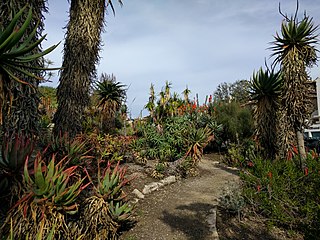
The Mathias Botanical Garden is a 7-acre (2.8 ha) botanical garden with over 3,000 species of plants, located on the southeastern corner of the University of California, Los Angeles (UCLA) campus. It is named after Mildred Esther Mathias Hassler (1906–1995), a noted American botanist. The director is Victoria Sork. It is also the only free public botanical garden in the Greater Los Angeles area.

The Harry P. Leu Gardens are semi-tropical and tropical gardens at 1920 North Forest Avenue in Orlando, Florida, United States. The gardens contain nearly 50 acres (200,000 m2) of landscaped grounds and lakes, with trails shaded by 200-year-old oaks and forests of camellias. They are open to the public.

The University of California, Riverside, Botanic Gardens are 40 acres of botanical gardens containing more than 3,500 plant species from around the world. The Gardens are located in the eastern foothills of the Box Springs Mountain on the University of California, Riverside campus in Riverside, California, US. Over four miles (6 km) of trails wind through many microclimates and hilly terrain.

Citrus medica var. sarcodactylis, or the fingered citron, is a citron variety whose fruit is segmented into finger-like sections, resembling those seen on representations of the Buddha. It is called Buddha's hand in many languages including English, Chinese, Japanese, Korean, Vietnamese, and French.
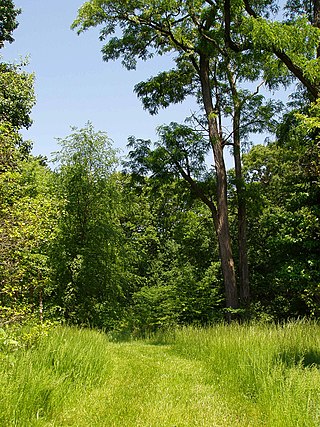
Rutgers Gardens is the official botanical garden of Rutgers University, located on the outskirts of Rutgers School of Environmental and Biological Sciences, at 112 Log Cabin Road, North Brunswick, New Jersey, 08902. The grounds include 60 acres of designed beds, specialty gardens, tree and shrub collections, lawns, and walking paths, and the adjoining 70-acre Frank G. Helyar Woods. The gardens are open year-round, without fee, and feature horticultural collections arranged in garden settings. In 2017 it was granted landmark status by the American Society for Horticultural Science.
This is an alphabetical index of articles related to gardening.

The Berlin Botanic Garden and Botanical Museum is a botanical garden in the Lichterfelde locality of the borough of Steglitz-Zehlendorf, Berlin, Germany. Constructed between 1897 and 1910 under the guidance of architect Adolf Engler, it has an area of 42 hectares [ha] and over 20,000 different plant species. The garden is part of the Free University of Berlin and attracts about half a million visitors annually.

The ponderosa lemon is a citrus hybrid of a pomelo and a citron. It is not the same as the 'Yuma Ponderosa' lemon-pomelo hybrid used as citrus rootstock.

The 'Mallika' mango is the result of the hybridization of the Indian mango varieties Neelum and Dasheri. The variety was introduced by Dr. Ramnath Singh. When grafted, the tree will remain a manageable size and is appropriate for dooryard growing. Fruit is normally ready to harvest from June to July.
Tsentralny city district is one of four city districts of the city of Sochi in Krasnodar Krai, Russia. Sometimes referred to as "Sochi proper", it borders Lazarevsky city district in the west and Khostinsky city district in the north and in the east. In the southwest, it is bounded by the Black Sea. Population: 137,677 (2010 Census); 133,935 (2002 Census); 137,968 (1989 Soviet census).

Henarathgoda Botanical Garden, also known as Gampaha Botanical Garden, is one of the six botanical gardens in Sri Lanka. The botanical garden is situated on the Gampaha-Minuwangoda main road, approximately 450 m (1,480 ft) away from Gampaha railway station. It is about 29 km (18 mi) from Sri Lanka's commercial capital of Colombo.
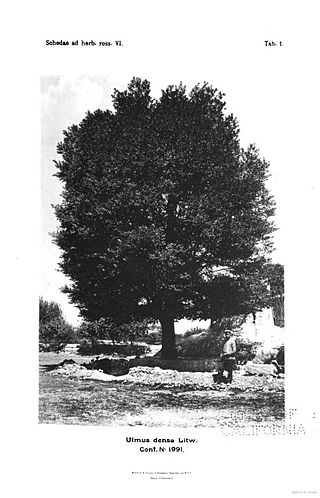
The elm cultivar UlmusDensa was described from specimens growing near Ashkabad as U. densaLitv. in Schedae ad Herbarium Florae Rossicae (1908). Litvinov, reporting it growing wild in the mountains of Turkestan, Ferghana, and Aksu, as well as in cultivation, considered it a species, a view upheld by the Soviet publications Trees and Shrubs in the USSR (1951) and Flora of Armenia (1962), and by some current plant lists. Other authorities take it to be a form of U minor, distinctive only in its dense crown and upright branching. The Moscow State University herbarium gives (2020) Ulmus minor as the "accepted name" of U. densaLitv..
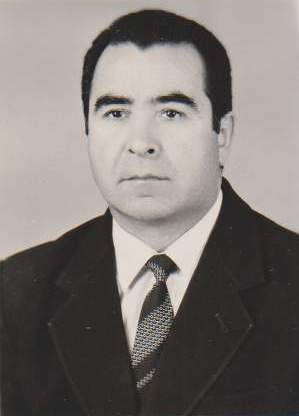
Khudoyor Yusufbekovich Yusufbekov was a Soviet scientist and organizer of scientific projects and institutes in Pamir. He was a leading scientist who made a significant contribution to the development of biological sciences, whose name is connected with a new direction of the development of plant growing in the arid mountain and highland territory of Pamir-Alay; a prominent specialist in the field of plant growing, plant introduction and pasture economy, meadow studies, phyto-amelioration, and botany, Yusufbekov was a practicing field researcher, figure of higher education, and professor. In 1968, he developed a system for fodder improvement in the Pamir and Alay valleys that was differentiated from the perspective of the ecological and geographical areas and high-altitude zones. He also implemented a system of arid fodder, and proposed methods of cultivation of useful plants in the Pamir area in 1972. In 1970—1975, Khudoyor Yusufbekov developed the master plan of reconstruction of the Pamir Botanical Garden. In 1969, he became doctor of the agricultural sciences. In 1976, he became an Academician of the Academy of Sciences of the Tajik Soviet Socialist Republic. In 1962—1969, he was the director of the Pamir Biological Station; at the same time in 1965—1990, he was the Chairman of the Bureau of the Pamir Base; in 1969—1981, the director of the Pamir Biological Institute of the Academy of Sciences of the Tajik SSR; in 1981—1986, the rector of the Tajik Agricultural Institute of the Ministry of Agriculture of the USSR; in 1986—1990, the Academician Secretary of the Biological Department of the Academy of Sciences of the Tajik SSR. From 1989, he was a Member of the Presidium of Academy of Sciences of the Tajik SSR. Moreover, he was a state and public figure, the head of the scientific council of the department of biological science of the Academy of Sciences of the Tajik SSR and a Member of the coordination council of the department of general biology of the Academy of Sciences of the USSR (1987—1990). He was also a fellow of the Geographical Society of the USSR since 1965, Member of the All-Union and Central Asian Councils of the Botanical Gardens of the USSR (1972—1990), Member of the Council on the "Biological Foundations of the Rational Use and Protection of Flora" of the Academy of Sciences of the USSR (1976—1990), Member of the Council on the "Biological Foundations of the Development of Mountain Territories in Central Asia" (1975—1990), Member of the Council of the All-Union Botanical Society (1976—1990).
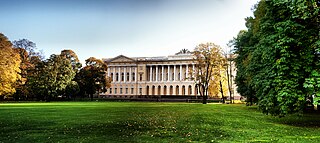
The Mikhailovsky Garden is a large area of parkland and landscape garden in the centre of Saint Petersburg.

The Balkan Botanic Garden of Kroussia (BBGK) is a botanical garden in northern Greece that was funded by the Inter-Regional Developmental Initiatives of the European Union. It was founded May 19, 2001, as an initiative of the Hellenic Agricultural Organization "Demeter". It is a member of the Botanic Gardens Conservation International (BGCI) and National Network of Hellenic Botanic Gardens. The research and services of BBGK are supported by the Laboratory of Protection and Exploitation of Native and Floricultural Plants located at Thermi of Thessaloniki.






